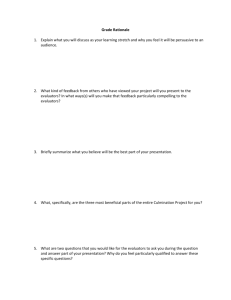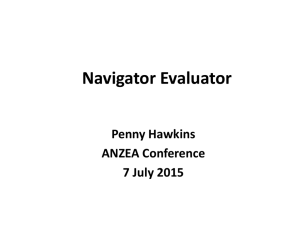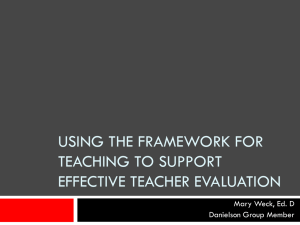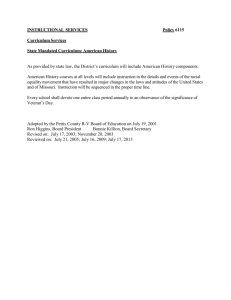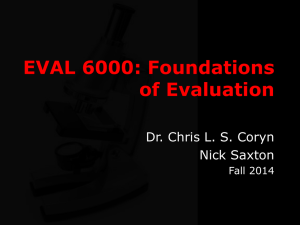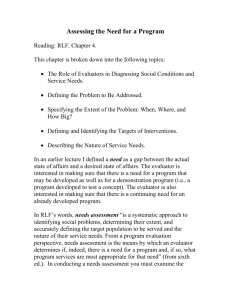th e m e /
advertisement
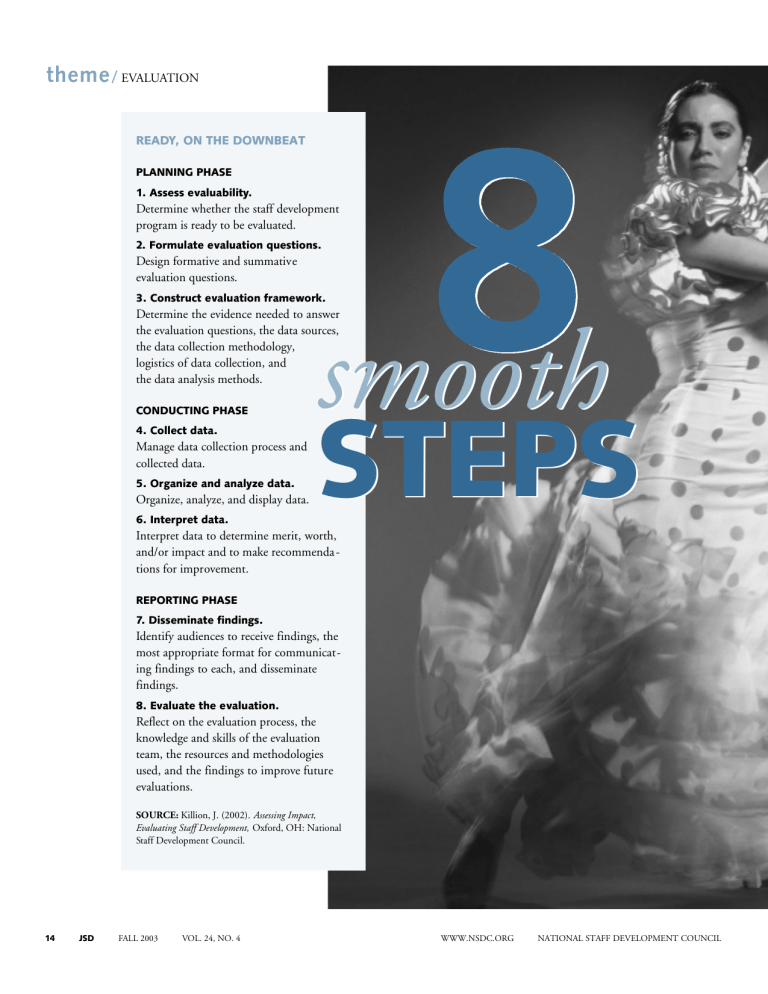
th e m e / EVALUATION READY, ON THE DOWNBEAT PLANNING PHASE 1. Assess evaluability. Determine whether the staff development program is ready to be evaluated. 2. Formulate evaluation questions. Design formative and summative evaluation questions. 3. Construct evaluation framework. Determine the evidence needed to answer the evaluation questions, the data sources, the data collection methodology, logistics of data collection, and the data analysis methods. CONDUCTING PHASE 4. Collect data. Manage data collection process and collected data. 5. Organize and analyze data. Organize, analyze, and display data. 6. Interpret data. smooth STEPS Interpret data to determine merit, worth, and/or impact and to make recommenda tions for improvement. REPORTING PHASE 7. Disseminate findings. Identify audiences to receive findings, the most appropriate format for communicating findings to each, and disseminate findings. 8. Evaluate the evaluation. Reflect on the evaluation process, the knowledge and skills of the evaluation team, the resources and methodologies used, and the findings to improve future evaluations. SOURCE: Killion, J. (2002). Assessing Impact, Evaluating Staff Development, Oxford, OH: National Staff Development Council. 14 JSD FALL 2003 VOL. 24, NO. 4 WWW.NSDC.ORG NATIONAL STAFF DEVELOPMENT COUNCIL th e m e / EVALUATION SOLID FOOTWORK MAKES EVALUATION OF STAFF DEVELOPMENT PROGRAMS A SONG BY JOELLEN KILLION E valuating the effectiveness of staff development and demonstrating its impact on student achievement are more important than ever. The language in staff development policies requires districts to show evidence of professional learning’s ability to improve student learning. The National Staff Development Council, some states’ legislation, and the federal No Child Left Behind Act all call for rigorous evaluation of professional learning programs (see “Dancing to the same tune” on the JOELLEN KILLION is director of special projects for the National S taff Development Council. You can contact her at 10931 W. 71st Place, Ar vada, CO 80004-1337, (303) 432-0958, fax (303) 432-0959, e-mail: NSDCKillio@aol.com. NATIONAL STAFF DEVELOPMENT COUNCIL (800) 727-7288 next page). With more emphasis on accountability, staff developers will want to explore ways to evaluate their programs and to link staff development to student learning. An evaluation also will help providers and leaders improve their programs. “Evaluation is a systemic, purposeful process of studying, reviewing, and analyzing data gathered from multiple sources in order to make informed decisions about a program” (Killion, 2002, p. 42). A good evaluation of a professional learning program can be accomplished by following eight steps. This eight-step process is drawn from extensive practice and research in program evalua tion. STEP 1: ASSESS EVALUABILITY The first step is determining the degree to which a program, as planned, is ready to be evaluated. VOL. 24, NO. 4 FALL 2003 JSD 15 Sometimes staff development leaders and providers want to link an episode of staff development, such as a workshop or single professional development day, to student learning. This is nearly impossible because the workshop or professional development day alone is insufficient to produce results for students or teachers. Evaluations of partial or insufficient staff development programs likely will yield disappointing results. Most staff development programs are inadequate to produce When the goals are the results they seek. “ We cannot expect results for expressed in terms of students from a staff student achievement, development program that is unlikely to produce the program’s design them. And we cannot expect an evaluation to is more likely to produce useful results include sufficient when the program being evaluated is poorly conactions to achieve ceived and constructed. them. Perhaps Chen (Chen, 1990) said it best: ‘Current problems and limitations of program evaluation lie more with a lack of adequate conceptual framework of the program than with methodological weakness’ ” (Killion, 2002). Before evaluating any staff development program, the evaluator asks whether the program is feasible, clear, sufficiently powerful to produce the intended results, and worth doing. To determine whether a program is ready to be evaluated, an evaluator analyzes the program’s goals, its standard of success, indicators of success, theory of change, and logic model. GOALS A staff development program’s goals express its intended results in terms of student achievement. Instead of “provide training to all teachers” as its goal, a results-driven program has as a goal improving student achievement. A sample goal might be to 16 JSD FALL 2003 VOL. 24, NO. 4 Dancing to the same tune From NSDC to state and federal legislation, the call for evaluation is loud and clear. NSDC The National Staff Development Council’s Standards for Staff Development state, “Staff development that improves the learning of all students uses multiple sources of information to guide improvements and demonstrate its impact” (Evaluation standard) (NSDC, 2001). In addition, the organization’s Code of Ethics for Staff Development Leaders, Principle III, states, “Staff development leaders continuously improve their work through the ongoing evaluation of staff development’s effectiveness in achieving school system and student learning goals.” The Code of Ethics for Staff Development Providers, Principle IV, states, “Staff development providers continuously learn and improve their performance” through ongoing evaluation of their work and feedback from clients, participants, and others affected by their work (NSDC, 2000). NO CHILD LEFT BEHIND No Child Left Behind, Title II, Part A, states that professional development programs will be “regularly evaluated for their impact on increased teacher effectiveness and improved student academic achievement, with the findings of the evaluations used to improve the quality of professional development.” It continues, “Ultimately the program’s performance will be measured by changes in student achievement over time as shown through the other NCLB reporting requirements.” STATES States, too, call for evaluating professional development. For example, in Florida, the state legislature enacted Florida Statute 231.600, School Community Professional Development Act, resulting in the Florida Professional Development Evaluation System Protocol. The protocol requires districts, schools, and other state agencies providing professional development to conduct ongoing formal evaluation to determine whether: • The planned professional development was implemented; • The new learning is applied in classrooms; • The professional development contributes to student performance gains, if the effect of training on student achievement is demonstrated on standardized achievement tests or other achievement measures; • The results of the evaluation serve as part of a needs assessment for determining which programs to offer or discontinue; • Resources are appropriately allocated for professional development that meets state priorities of content standards, subject area content, instructional methodology, assessment, technology, classroom management, and school safety; and • Overall school grades increase. WWW.NSDC.ORG NATIONAL STAFF DEVELOPMENT COUNCIL improve student achievement in mathematics by 2005 by 10% as measured on the state assessment. When the goals are expressed in terms of student achievement, the program’s design is more likely to include sufficient actions to achieve them. STANDARD OF SUCCESS A program’s standard of success is the benchmark that defines its success. It typically is a number representing the performance increase that, when met, is sufficient to declare the program a success. If the goal does not specify a particular degree of improvement, then any degree of improvement, even 0.002, may indicate success. Most staff development leaders want a specific increase in student performance as a return on their investment. For example, in the goal above, the standard of success is 10%. If the staff development program increases student achievement by 10% in mathematics, it is declared a success. If not, it falls short of its intended results and may be altered to increase effectiveness in subsequent years. INDICATOR OF SUCCESS An indicator of success is the specific way success will be demonstrated. It is the way an evaluator will know if the standard of success has been achieved. In the example above of a 10% increase in math test scores, the indicator of success is student performance on the state assessment in mathematics. Certainly other indicators might be used to demonstrate students’ increased achievement in math: performance on other assessments, classroom tasks, enrollment of underrepresented populations in advanced level courses, grades, performance on a national standardized test, or a combination of these. Program designers might specify single or multiple indicators of success. Program designers must identify both a standard of success and indicator of success early when planning a staff development program so the program’s design can be tailored to achieve the desired results. THEORY OF CHANGE A theory of change requires program designers to think carefully about how their program will bring about the changes they want. A theory of change (see diagram below) specifies how change is expected to happen, the program’s components, their sequence, and the assumptions upon which the program is based (Killion, 2002). An explicit theory of change is a roadmap for program designers, managers, participants, stakeholders, and evaluators showing how the program will work. It is the big picture that serves as a planning tool, an implementation guide, a monitoring tool, and a tool for evaluating the program’s success. It allows the program designers to explain how they see the connection between educator learning and student achievement. Without the theory of change, the connection between the program’s components and its results may be unclear. Any one program can have multiple theories of change. Individual theories are neither right nor wrong, but one may be more appropriWithout the theor y ate for a specific context and circumstances. Theories of change, the can be based on other theoconnection between ries, research, or best practice. For example, the social the program’s interaction theory of learn components and its ing might serve as the basis for designing how adult results may be learning happens in a professional development prounclear. gram. Based on this theory, participants would have multiple, frequent, in-depth opportunities to process their learning with colleagues. LOGIC MODEL A logic model is a particular kind of action plan that specifies the inputs, activities, initial, intermediate, and intended outcomes that will accomplish the identified goal. Thorough planning increases a program’s potential to succeed. Planning THEORY OF CHANGE FOR TECHNOLOGY INTEGRATION A SAMPLE 1. Key leaders hold vision for project. 2. 3. Leaders Technology develop resources partnerships are readily and plan for available for project. teachers and students. 4. Teachers receive professional development that includes training, curriculum development, and support. 5. Teachers change classroom instructional practices. 6. Teachers provide inquiry and explorationbased student learning activities. 7. Students engage in learning. 8. Student achievement increases. SOURCE: Killion, Munger, & Psencik, 2002 This theory of change is based on the following assumptions: • Thorough planning contributes to program’s success. • Integrating technology advances student learning. • To change instructional practice, teachers require opportunities to gain new knowledge and skills and appropriate resources. NATIONAL STAFF DEVELOPMENT COUNCIL (800) 727-7288 • Implementing new teaching practices improves student achievement. • When students are engaged in learning, they achieve. VOL. 24, NO. 4 FALL 2003 JSD 17 Logic model for professional development on technology integration A SAMPLE INPUTS ACTIVITIES INITIAL OUTCOMES INTERMEDIATE OUTCOMES • Technology Teachers and principals receive training on technology integration in mathematics. Teachers and principals develop an understanding of how technology can enhance students’ mathematics learning, engage students more actively in learning, differentiate learning and assessment. Teachers integrate technology into their mathematics instruction. hardware, software, and infrastructure • Planning time for integrating technology into Technology resources are deployed in mathematics classrooms. Teachers learn strategies for integrating technology into mathematics instruction. Teachers are coached on integrating technology into their mathematics curriculum. Teachers’ comfort with integrating technology increases and they design opportunities for students to use technology for learning. Skill Attitude and behavior lessons • Time for conferring with coaches Principals are trained in how to support teachers as they integrate technology into their classrooms and how to serve as a leader for technology in their schools. ensures that all the program’s activities align with the intended outcomes and that initial and intermediate outcomes will lead to the intended results. A logic model provides a framework for conducting the formative program evaluation as well as for the program design. (See sample logic model above.) The logic model identifies the benchmarks of progress toward a goal. The short-term outcomes lead to FALL 2003 Student Teachers integrate technology into their classroom instruction on a regular basis. Students use technology to gather information, construct understanding, demonstrate understanding, and engage more actively in learning. Behavior and aspiration mathematics JSD Behavior and aspiration Knowledge • Trainers 18 INTENDED RESULTS VOL. 24, NO. 4 In instructional conferences, principals provide support to teachers in integrating technology into their classrooms. Behavior Teachers’ attitudes about technology improve. achievement in mathematics increases by 10% by the year 2005. Attitude Students’ attitudes about technology improve. Attitude medium-term outcomes that lead to long-term outcomes. With this map of the outcomes in place, evaluators are able to determine which outcomes are important to collect evidence about in order to explain the link between staff development and student achievement (Killion, 2002). A logic model has several components. • Inputs: Resources assigned to a pro- gram including personnel, facilities, equipment, budget, etc. • Activities: Services the program provides to clients. • Initial outcomes: Changes in clients’ knowledge and skill as a result of early activities. • Intermediate outcomes: Changes in clients’ attitudes, aspirations, and behavior as a result of the knowledge and skills acquired. WWW.NSDC.ORG NATIONAL STAFF DEVELOPMENT COUNCIL • Intended results: Desired results of the program expressed as increases in student achievement. Building on the program’s theory of change, which identifies the program’s key components, the logic model specifies what will change as a result of each program component. Staff development is most successful in increasing student achievement when it targets changes in knowledge, attitude, skill, aspiration, and behavior (see “Spelling out KASAB” at right). For example, if one component of a staff development program is providing coaching to classroom teachers, the initial outcome of this might be that teachers become more motivated to implement the strategies in their classroom (teachers’ aspirations change). An intermediate outcome might be that teachers use the new strategies regularly (a teacher behavior change). The intended outcome is that student achievement increases (student knowledge, skill, and behavior change) as a result of teachers regularly implementing new instructional strategies in their classrooms. Knowing the precursors to the goal, program developers can monitor for evidence that the precursors are affecting student and teacher learning and adjust the program design to ensure that the precursors occur. Without monitoring, one cannot expect the intended results. For the evaluator, the precursors, or initial and intermediate outcomes, typically provide benchmarks for collecting evidence in the formative evaluation. To form a reasonable and supportable claim about the link between staff development and student achievement, the evaluator must know whether teachers received coaching, whether that coaching motivated them to implement the strategies, and whether teachers implemented the strategies. When developing a theory of NATIONAL STAFF DEVELOPMENT COUNCIL Spelling out KASAB KNOWLEDGE Conceptual understanding of information, theories, principles, and research. ATTITUDE Beliefs about the value of particular information or strategies. SKILL Strategies and processes to apply knowledge. ASPIRATION Desires, or internal motivation, to engage in a particular practice. BEHAVIOR Consistent application of knowledge and skills. change and the logic model, program designers specify the types of changes they want to occur. By clearly delineating these changes, designers will be able to design the appropriate actions to accomplish them. Often professional development program planners want teachers to change their behavior, for example, but plan actions that will change only teachers’ knowledge and skills. STEP 2: FORMULATE EVALUATION QUESTIONS The questions an evaluation attempts to answer shape the evaluation’s design. For example, if a formative evaluation asks whether teachers are integrating new technologies in their classrooms, the evaluation questions might be: • How frequently are teachers using technology in their mathematics lessons? • How well are teachers integrating technology into their mathematics instruction? (800) 727-7288 • How frequently do students use technology to demonstrate their understanding of mathematics? • For what learning tasks do teachers use technology? • In what other content areas are teachers integrating technology? • How do students use technology to learn? The theory of change and the logic model are used to generate formative evaluation questions. Questions can be formulated from each initial and intermediate outcome in the logic model, from each step of the theory of change, from both, or from steps in either that are pivotal to the program’s success. For example, for the theory of change and logic model above, an evaluator may choose not to measure whether teachers and principals learned about the value of technology, but rather to measure whether teachers are integrating technology in their Knowing the classrooms and whether principals are providing precursors to the the appropriate level of goal, program support to their teachers. An evaluator may assume developers can that, if a teacher is using monitor for technology appropriately, teachers know how techevidence that the nology contributes to stuprecursors are dent learning. Summative evaluation affecting student and questions ask whether the program achieved its goals. teacher learning and If the goals are written as adjust the program student achievement goals, then the evaluation is able design to ensure that to yield evidence about the the precursors occur. staff development’s impact on student achievement. If the goals are not expressed as student achievement goals, then the evaluation will allow claims about merit — the degree to which the program achieved its results — but not its impact on student achievement. The summative evaluation question for the goal expressed earlier is: Does student VOL. 24, NO. 4 FALL 2003 JSD 19 achievement in mathematics increase by 10% by 2005 as a result of integrating technology into the classroom? Evaluators craft questions that allow them to know whether the goal is achieved. To know whether technology integration influenced students’ achievement in mathematics, evaluators first examine the theory of change and logic model to understand how teacher learning influences student achievement and then design formative and summative evaluation questions that allow them to gather the appropriate evidence to make a claim that teacher learning contributes to student learning. Without first answering the formative questions, evaluators will be unable to claim that teachers’ learning contributes to student learning in mathematics. STEP 3: CONSTRUCT EVALUATION FRAMEWORK The evaluation framework is the plan for the evaluation. Decisions made in this step determine the evidence needed to answer the formative and summative evaluation questions, decide the appropriate sources of that evidence, determine appropriate and feasible data collection methods, the timeline for Data collection data collection, person(s) requires a systematic responsible for the data collection, and data analyand thoughtful sis method. Knowing what process to ensure change is expected helps the evaluator determine that data collected the best source of evidence are accurate and and the most appropriate data collection method. have been collected For example, if the as planned. evaluator wants to know whether teachers are using technology, teachers themselves are the best source of that information. To triangulate, the evaluator may want to include students, principals, 20 JSD FALL 2003 VOL. 24, NO. 4 Your dancing shoes are ready. TOOLS FOR SUCCESSFUL EVALUATION, PAGES 22-26. and documents as other data sources to confirm the accuracy of teachers’ judgments. Classroom observations of teachers integrating technology may be the most authentic data collection method for knowing whether teachers are using technology; however, evaluators may select alternative data collection methods that will be less timeconsuming or costly. Approximate indicators of teachers’ use of technology might include assignments, student work samples, student sur veys about technology use, principals’ observations, and system administrators’ records about student time using particular software programs. STEP 4: COLLECT DATA The evaluator next prepares for and collects the data. Evaluators will want to pilot newly developed or modified data collection instruments to ensure the instruments’ accuracy and clarity. Data collectors may require training to ensure consistency and data reliability if more than one individual is collecting data. Data collection processes must be refined for accuracy, and appropriate protocols for collecting data must be developed that give detailed explanations for how to collect data. Once these responsibilities are met, data are collected. This is relatively routine work for most evaluators, although this step WWW.NSDC.ORG holds the potential for compromising the quality of the evaluation if data are not accurately collected and recorded. When collecting data, evaluators adhere to standards established by the American Evaluation Association (1995) and the Joint Committee on Standards for Educational Evaluation (1994) on working with human subjects, if applicable. They ensure that they have met all the policy expectations of schools and districts for notification, privacy of records, or other areas, and abide by a code of ethics for evaluators. Data collection requires a systematic and thoughtful process to ensure that data collected are accurate and have been collected as planned. To ensure accuracy in this step, evaluators often create checks and balances for themselves to ensure that data are recorded accurately, that errors in data entry are found and corrected, and that missing data or outlier data are handled appropriately. Evaluators who attend to details well and who are methodical in their work collect data well. STEP 5: ORGANIZE AND ANALYZE DATA Evaluators must organize and analyze data collected. Evaluators ensure the data’s accuracy by checking for any abnormalities in the data set and checking that data are recorded appropriately and records are complete. Once evaluators are confident that the data have integrity, they analyze the data. Many practitioners distrust their own ability to do a statistical analysis. But in most cases, simple analyses such as counting totals, finding patterns and trends, or simple calculations such as determining the mean, median, mode, and range are sufficient. Sometimes it may be appropriate to use more sophisticated comparisons that include factoring, assessing covariance, or creating statisNATIONAL STAFF DEVELOPMENT COUNCIL tical models. When evaluators want this level of analysis, they might want to get help from someone experienced in inferential statistics. Once data are analyzed, they are displayed in charts, tables, graphs, or other appropriate formats to allow people with different preferences to find the format that works best for them. Careful titling and labeling helps ensure that readers interpret the data accurately. pants’ perception of the program’s value, and the program’s contribution to student learning. Claims of contribution, those stating that the program influenced student achievement, are made when the evaluation design is descriptive or quasi-experimental. Claims of attribution, that staff development and nothing else caused the results, require experimental, randomized design not often used in evaluation studies. STEP 6: INTERPRET DATA STEP 7: DISSEMINATE FINDINGS While data analysis is the process of counting and comparing, interpreting is making sense of what the analysis tells us. “Interpretation is the ‘meaning-making’ process that comes after the data have been counted, sorted, analyzed, and displayed” (Killion, 2002, p. 109). For example, we can tell that the scores went up if we compare scores over three years (analysis). In the interpretation phase, we ask what that means in terms of our work — what contributed to the increase, what does the increase mean, was the increase consistent across all grades, etc.? Evaluators seek multiple interpretations and talk with stakeholders about which interpretations are most feasible from their perspective. The evaluators then determine which interpretations are most supported by the analyzed data (Killion, 2002). Interpreting data is best done as a collaborative process with program designers and key stakeholders, including participants. In most evaluations of staff development programs, this means that teachers, principals, and central office staff together study the data and form claims about the program’s effectiveness and impact on student learning, and then recommend improvements. Evaluators form claims about a program’s merit, the degree to which it achieved its goals, its worth, partici- After they interpret data, evaluators share their findings. Evaluators must decide what audiences will receive results and the most appropri ate formats in which to share those results since different audiences require different formats. Formats for sharing evaluation results include technical reports, brief executive summaries, pamphlets, newsletters, news releases to local media, and oral presentations. Evaluations sometimes fail to have an impact on future programs because results are not widely shared with key stakeholders. NATIONAL STAFF DEVELOPMENT COUNCIL (800) 727-7288 STEP 8: EVALUATE THE EVALUATION Evaluations rarely include this step. Evaluating the evaluation involves reflecting on the evaluation process to assess the evaluator’s work, the resources expended for evaluation, and the overall effectiveness of the evaluation process. Evaluating the process is an opportunity to improve future evaluations and strengthen evaluators’ knowledge and skills. “When evaluators seek to improve their work, increase the use of evaluation within an organization, and build the capacity of others to engage in ‘evaluation think,’ they contribute to a greater purpose. Through their work, they convey the importance of evaluation as a process for improvement and ultimately for increasing the focus on results” (Killion, 2002, p. 124). CONCLUSION Evaluating staff development requires applying a scientific, systematic process to ensure reliable, valid results. Evaluation not only provides information to determine whether programs are effective, it provides information about how to strengthen a program to increase its effectiveness. With more limited resources available today for professional learning, staff development leaders will face harder decisions about how to use those resources. Evaluations can provide the evidence needed to make these critical decisions. REFERENCES American Evaluation Association Task Force. (1995). Guiding principles for evaluators. New Directions for Evaluation, 66, 1934. Chen, H. (1990). Theory-driven evaluation. Newbury Park, CA: Sage Publications. Killion, J. (2002). Assessing impact: Evaluating staff development. Oxford, OH: National Staff Development Council. Killion, J., Munger, L., & Psencik, K. (2002). Technology innovation: Initiating change for students, teachers, and communities. Oxford, OH: National Staff Development Council. National Staff Development Council. (2000). Staff development code of ethics. Oxford, OH: Author. National Staff Development Council. (2001). NSDC’s standards for staff development, revised. Oxford, OH: Author. The Joint Committee on Standards for Educational Evaluation. (1994). Program evaluation standards (2nd ed.). Thousand Oaks, CA: Sage Publications. ■ VOL. 24, NO. 4 FALL 2003 JSD 21 ↔ Keep the whole process in mind STEPS 1-8, PAGES 15-21 STEPS TO YOUR OWN EVALUATION kitL TOO S PE C I A L hese tools are structured to help evaluation practitioners apply an eight-step process for planning, conducting, and reporting their impact evaluations. The tools will assist evaluators in making essential decisions for impact evaluations of professional learning programs. We invite you to use these tools to begin your own evaluations. T BY JOELLEN KILL IO N, NS DC DIR EC TOR O F S PEC IAL PRO J E C TS START BY ASKING: • What is the purpose of this evaluation? • Who are the primary users of the evaluation results? • What is their intended plan for using the results? STEP 1: ASSESS EVALUABILITY 1. What are the program’s goals? Are they plausible, student-focused, and results-oriented? 2. What are the program’s objectives? • Are they measurable? • Do they specify the intended change (knowledge, attitude, skill, aspiration, behavior)? 3. Have the standards for acceptable performance been established for all the targeted participants and clients? 4. What are the assumptions upon which the program is based and that make up the program’s theory of change? Has the theory of change been created? 5. What is its logic model? In other words, what are the inputs, activities, initial outcomes, intermediate outcomes, and SOURCE: Assessing Impact: Evaluating Staff Development, by Joellen Killion (Oxford, OH: National Staff Development Council, 2002). 22 JSD FALL 2003 VOL. 24, NO. 4 intended results of this program? Has the logic model been created? 6. Do the program’s theory of change and logic model make sense? 7. Do key stakeholders understand the program’s theory of change? 8. Is this evaluation worth doing? STEP 2: FORMULATE EVALUATION QUESTIONS 1. What are the evaluation questions? • Program need • Program design • Program implementation • Program impact • Multiple use 2. How well do the evaluation questions reflect the interests of the primary users of the evaluation results? 3. How well do the evaluation questions align with the program’s goals and purpose of the evaluation? 4. Are the evaluation questions: • Reasonable? • Appropriate? • Answerable? • Specific, regarding measurable WWW.NSDC.ORG or observable dimensions of program success or performance? • Specific, regarding the measure of program performance? STEP 3: CONSTRUCT THE EVALUATION FRAMEWORK 1. Determine evaluator. • Who will conduct the evaluation? ➔ Internal evaluator ➔ External evaluator ➔ Combination • Does the designated evaluator have the knowledge, skills, and resources to conduct the evaluation? 2. Decide how to answer evaluation question(s). • What are the key constructs (terms such as student achievement, improvement, increase, professional development) that will be measured? How have they been defined so that they are clear and specific? • Does the evaluation question require making a comparison to determine impact? If so, NATIONAL STAFF DEVELOPMENT COUNCIL what are possible comparison groups? Which is the most appropriate comparison group for this evaluation? ➔ Cohort ➔ Individual ➔ Group ➔ Panel ➔ Generic 3. Create data plan. • Who or what is expected to change as a result of this staff development program? • What types of changes are expected as a result of this staff development program in the identified target audiences or organizational structures? ➔ Knowledge ➔ Attitudes ➔ Skills ➔ Aspirations ➔ Behavior • What data can provide evidence that the changes intended have occurred? • What data collection methodology is most appropriate for the needed data? • From whom or what will the data be collected? • What are other possible sources of data to provide evidence of the intended change? • How essential is it to have multiple data sources for this evaluation? • When will the data be collected? • Where will the data be collected? 4. Determine cost. • Are needed resources including time, fiscal resources, and personnel available to conduct this evaluation? • If resources are not adequate, what aspects of the evaluation plan can be modified without compromising the integrity of the evaluation? • If resources are inadequate, how will the evaluation be affected? • Is the evaluation worth doing? NATIONAL STAFF DEVELOPMENT COUNCIL STEP 4: COLLECT DATA 1. Have the instruments and procedures for data collection been field tested? 2. What revisions are necessary? 3. How will data collectors be trained? 4. After early data collection, do any data seem redundant? What are the advantages and disadvantages of continuing to collect these data? Is it appropriate to continue or to discontinue collecting these data? 5. After early data collection, what data seem to be missing? Is it essential to collect these missing data? How will a new data collection methodology be implemented to collect these data? 6. What processes have been established to manage data collection and transfer? 7. What processes are established to ensure safekeeping and integrity of data? 8. If collecting quantitative data, what kinds of scores are needed to accurately reflect the data and to answer the evaluation questions? STEP 5: ORGANIZE AND ANALYZE DATA 1. How will data be sorted, grouped, and arranged before analysis? 2. What method of data analysis is needed to answer the evaluation question? • Univariate analysis • Multivariate analysis 3. How will data be displayed to facilitate interpretation and understanding? 4. How will stakeholders be involved in the data analysis process? STEP 6: INTERPRET DATA 1. What do these data mean? 2. What findings (interpretations/ claims) can be made from these data? 3. How well supported are the findings? (800) 727-7288 • Major ➔ Strong ➔ Weak • Minor ➔ Strong ➔ Weak 4. Does this evaluation support claims of attribution or contribution? 5. Does this program have merit or worth? 6. What recommended actions can help the program stakeholders improve their programs and program impact? kitL TOO S PE C I A L STEP 7: DISSEMINATE FINDINGS 1. Will the evaluation reports be interim or final evaluation reports? 2. Who are the primary users of the evaluation report? 3. What components do the primar y users want included in the evaluation report? 4. What format for reporting the results is most appropriate for the primary users of the evaluation report? 5. What other audiences are likely to want some version of the evaluation report? 6. What format for reporting the results is appropriate for other audiences? SOURCE: Assessing STEP 8: EVALUATE THE EVALUATION 1. How will the effectiveness of the evaluation be assessed? 2. What questions will guide the evaluation of the evaluation? • Resources • Design • Findings • Reporting • Evaluator 3. What stakeholders will be involved in the evaluation of the evaluation? How will they be involved? ■ VOL. 24, NO. 4 FALL 2003 Impact: Evaluating Staff Development, by Joellen Killion (Oxford, OH: National Staff Development Council, 2002). JSD 23 ↔ List the planning goals and objectives SEE STEP 1, PAGES 15-17, 22 PLANNING GOALS AND OBJECTIVES Intended results (stated in terms of student achievement): kitL TOO S PE C I A L Students Teachers Principals MEASURABLE OBJECTIVES (specify as appropriate) Central office Organization (Policy, practices, structures, systems, etc.) K A S A B KNOWLEDGE ATTITUDE SOURCE: Assessing Impact: SKILL Evaluating Staff Development, by Joellen Killion (Oxford, OH: ASPIRATION National Staff Development Council, 2002). BEHAVIOR 24 JSD FALL 2003 VOL. 24, NO. 4 WWW.NSDC.ORG NATIONAL STAFF DEVELOPMENT COUNCIL Make a logic model planning guide ↔ SEE STEP 1, PAGES 17-19, 22 LOGIC MODEL PLANNING GUIDE Intended results/goals (stated in terms of student achievement): kitL TOO S PE C I A L INPUTS ACTIVITIES INITIAL OUTCOMES INTERMEDIATE OUTCOMES INTENDED RESULTS SOURCE: Assessing Impact: Evaluating Staff Development, by Joellen Killion (Oxford, OH: National Staff Development Council, 2002). NATIONAL STAFF DEVELOPMENT COUNCIL (800) 727-7288 VOL. 24, NO. 4 FALL 2003 JSD 25 ↔ Create an evaluation framework SEE STEP 3, PAGES 20, 22-23 EVALUATION FRAMEWORK Program goal: Measurable objectives/ changes See pages 17-19 kitL TOO Evaluation questions Formative and summative Data/ evidence needed Data source Data collection method Data analysis method Timeline Responsible person(s) S PE C I A L Evaluation framework A SAMPLE SOURCE: Evaluation questions Data/ evidence needed Data source Data collection method Data analysis method Timeline Responsible person(s) How frequently are teachers integrating technology into their mathematics lessons? Teacher behavior Teacher self-report Principal observations Survey Count Logs Count with description Technology coordinator Principal Lesson plans Artifacts Quality analysis Administer survey in May Principal observations October through May Collect artifacts in February and May Student self-report Interviews Patterns Graduate students Classroom assignments Samples of student work Artifacts Quality analysis Quality analysis Conduct student interviews in May Collect artifacts in February and May State test Artifacts Comparing April Classroom tests Student grades Artifacts Artifacts Comparing Comparing October-June June District testing coordinator Teachers District testing coordinator Assessing Impact: Evaluating Staff Development, How do students use technology in mathematics? by Joellen Killion Student behavior (Oxford, OH: National Staff Development Council, 2002). Is student achievement in mathematics increasing as expected? (10% on state tests by 2005) 26 JSD FALL 2003 Student knowledge and skills VOL. 24, NO. 3 Artifacts WWW.NSDC.ORG Technology coordinator Technology coordinator NATIONAL STAFF DEVELOPMENT COUNCIL
